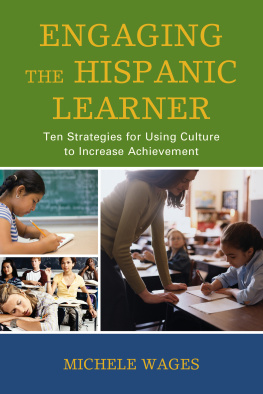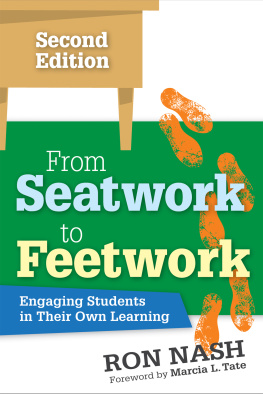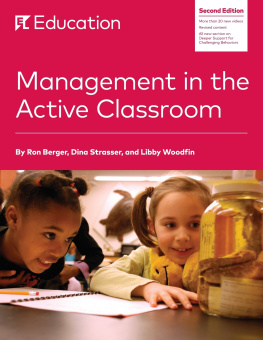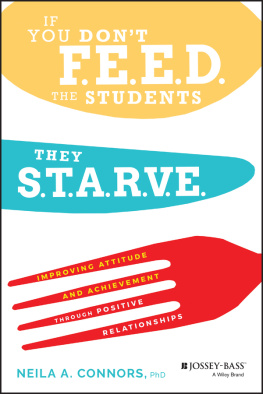Engaging the Hispanic Learner
Engaging the Hispanic Learner
Ten Strategies for Using Culture to
Increase Achievement
Michele Wages, PhD
ROWMAN & LITTLEFIELD
Lanham Boulder New York London
Published by Rowman & Littlefield
A wholly owned subsidiary of The Rowman & Littlefield Publishing Group, Inc.
4501 Forbes Boulevard, Suite 200, Lanham, Maryland 20706
www.rowman.com
Unit A, Whitacre Mews, 26-34 Stannary Street, London SE11 4AB
Copyright 2015 by Michele Wages
All rights reserved. No part of this book may be reproduced in any form or by any electronic or mechanical means, including information storage and retrieval systems, without written permission from the publisher, except by a reviewer who may quote passages in a review.
British Library Cataloguing in Publication Information Available
Library of Congress Cataloging-in-Publication Data
Wages, Michele, 1965
Engaging the Hispanic learner : ten strategies for using culture to increase achievement / Michele Wages.
pages cm.
Includes bibliographical references.
ISBN 978-1-4758-1385-2 (cloth : alk. paper) ISBN 978-1-4758-1386-9 (pbk. : alk. paper) ISBN 978-1-4758-1387-6 (electronic)
1. Hispanic AmericansEducation. 2. Hispanic AmericansEducationSocial aspects. 3. Hispanic American studentsSocial conditions. 4. Educational anthropologyUnited States. 5. Community and schoolUnited States. I. Title.
LC2669.W34 2014
371.829'68073dc23
2014029860
 TM The paper used in this publication meets the minimum requirements of American National Standard for Information Sciences Permanence of Paper for Printed Library Materials, ANSI/NISO Z39.48-1992.
TM The paper used in this publication meets the minimum requirements of American National Standard for Information Sciences Permanence of Paper for Printed Library Materials, ANSI/NISO Z39.48-1992.
Printed in the United States of America
Do you need help in identifying how culture is affecting your Hispanic students educational success? Within the pages of this book you will discover ten effective instructional strategies along with numerous examples based on Hispanic cultural perceptions of education. Each chapter is self-sufficient, allowing the reader to utilize only those parts of the book needed. This is an invaluable educator resource addressing the increasingly diverse student population in todays classroom.
Michele Wages
Foreword
What can I do differently, to better help my Hispanic students?
This is one of the fundamental questions every teacher must now ask, every year, as a new group of students walks through the classroom door. The reason, quite simply, is that the percentage of Hispanic students in US classrooms is increasing dramatically each year. As educators, what should we do, what should we change, what should we try, that might better help these students maximize their potential?
In the past, educations overall approach was to let Hispanic learners simply adapt to the typical US, anglo-dominated classroom culture. The expectation was they would acclimate themselves to the current norms. In fact, it was almost as if there was an unspoken rule that it was the students responsibility to figure out how to fit in. If, arguably, that indeed was the situation, it is certainly no longer true. Given the seismic shift in percentages, its time for schools and teachers to proactively develop learning environments that will support these students in the best possible way.
For many teachers, this is not news. Theyve seen the growing need for a response to the changing dynamics of classroom populations over the last few years. In my experience, however, what has been lacking are specific strategies we can implement to properly address the situation. While identifying the issue and seeing the need for change are both important, the next step is knowing what to doand doing it.
In Engaging the Hispanic Learner, Michele Wages helps education take an enormous step forward in addressing this increasingly complex issue. The research she cites is almost shockingly compelling. After reading this book there should be no doubt in anyones mind that the issue is real, the issue is important, and that successfully dealing with itsoonis critical.
Perhaps most importantly, she offers us specific things we can do to better meet this challenge. The ten strategies she offers are practical, applicable, and achievable. When successfully applied they will work together to produce a better result than any one alone might create.
However, with that being said, for those short on time, the good news is that you dont have to read it all. One of the wonderful things about Engaging the Hispanic Learner is that you dont have to read far before the vital, practical pieces of the puzzle start to fall into place. Just by dipping anywhere into the book, teachers will be able to begin implementing Michele Wages ideas immediately. This makes the book a highly valuable resource for busy teachers, who can look at almost any section and within a few minutes select an idea, a tool, or a strategy, and put it into action the next day.
Some people will likely see the issue of addressing the needs of Hispanic learners as a lesser problem than other issues we are currently facing in education. Yet perhaps the more useful thought would be to see it as the tremendous opportunity it truly is. These students are going to be an important part of our countrysand indeed the worldsfuture. The sooner we address the situation, the sooner they can and will become positive, powerful, and productive contributors to society.
The time is certainly right for education to step up and take charge of this critical situation. Its time for us to reach out and lend a hand where its greatly neededto help these students who so desperately need our assistance. Its time for us to switch from passive response mode into proactive action mode, and make some real changes for the better.
In Engaging the Hispanic Learner, Michele Wages has given us an important, practical starting point from which we can begin this essential journey.
Dr. Rich Allen
Preface
The census bureau has predicted that by the year 2100, the minority will become the majority, with non-Hispanic whites comprising only 40 percent of the US population (Noor, 2012). According to the National Center for Educational Statistics (NCES) 2011, Black and Hispanic youth are more likely than whites or Asians to drop out of high school.
In 2012, 4 percent of anglo students ages sixteen to twenty-four were not enrolled in school and had not completed high school, compared with 9 percent of blacks and 13 percent of Hispanics. The high rate for Hispanics not completing school is partly due to the high proportion of immigrants in this age group who never attended school in the US. Also included in this report was the fact that the higher dropout rate existed among Hispanics who were foreign born (31 percent) versus those who were native born (10 percent), which partially accounts for the relatively high overall Hispanic dropout rate of 16 percent.
Costantini (2012) found that Hispanic students were less likely to graduate from high school than whites and Asians in all but two states over the 20102011 school year. Those two states, Maine and Hawaii, showed Hispanic graduation rates slightly higher than those of their white peers. Approximately 42 percent of Hispanic students, 43 percent of African American, and 46 percent of American Indian students will not graduate on time with a regular diploma, compared to 17 percent of Asian students and 22 percent of white students (Alliance for Excellent Education (AEE, 2011). Nationally, of the 71 percent of all students that graduate from high school on time, less than half of Hispanic students earn diplomas with their peers (Virginia Department of Education, 2009).
Next page









 TM The paper used in this publication meets the minimum requirements of American National Standard for Information Sciences Permanence of Paper for Printed Library Materials, ANSI/NISO Z39.48-1992.
TM The paper used in this publication meets the minimum requirements of American National Standard for Information Sciences Permanence of Paper for Printed Library Materials, ANSI/NISO Z39.48-1992.